Sustainability/Green
History Made: Mercedes-Benz EQS
Mercedes-Benz has long been seen as the leader in trickle-down technology being seen in cars some years after featuring in the brand’s higher end saloons such as the S-Class. And with the release of their first all electric luxury vehicle, the EQS, this tradition is set to continue.
The EQS will offer ranges of up to 770 kilometres and will pack a powertrain of up to 385kW. A performance version is said to be in development and with up to 560kW. It will sit within the expectations of the S-Class saloon segment. The vehicles will be rear axle driven however the models fitted with the 4MATIC will have a front axle engine also.
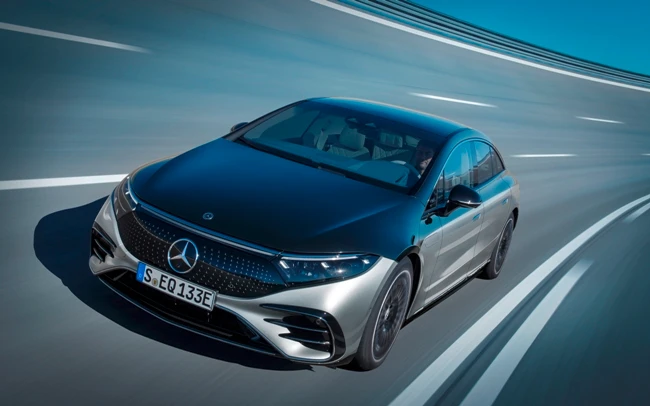
Mercedes-EQ, EQS, V 297, 2021
Mercedes says the initial models will be the EQS 450+ with 245 kW and the EQS 580 4MATIC with 385 kW. The rated power consumption rates are quoted as 20.4-15.7 kWh/100 km, and 21.8-17.4 kWh/100 km. New technology for the batteries has them enabled with a higher energy density. Of the two batteries to be available, the larger will have a usable energy content of 107.8 kWh. Mercedes says this is around 26 percent more than the EQC, their EV SUV.
It’s tech that is bespoke for M-B, with the software having been fully developed by the company and allowing over the air updates. This keeps the management system up to date, and for the life cycle of the battery. In respect to the charging rates, the DC fast charge stations pump in 200kW( and 300km in around 15 minutes. On a home charger system the EQS charges up to 22kW with AC power. The software will also allow intelligent charging programs and battery-saving charging.
A key component of EV technology is is energy recuperation. The EQS uses a program called DAuto, which can recuperate energy from deceleration to zero without the need for the brake pedal to be utilised. Smart cruise tech employs the same mechanisms with vehicle traffic ahead of the EQS. Intelligent energy recovery is situation-optimised with the aid of ECO Assist and acts with foresight, taking into account traffic conditions or topography, among other things, and up to 290kW can be generated. The driver also can set three energy recovery levels and the coast function via paddle shifters on the steering wheel.
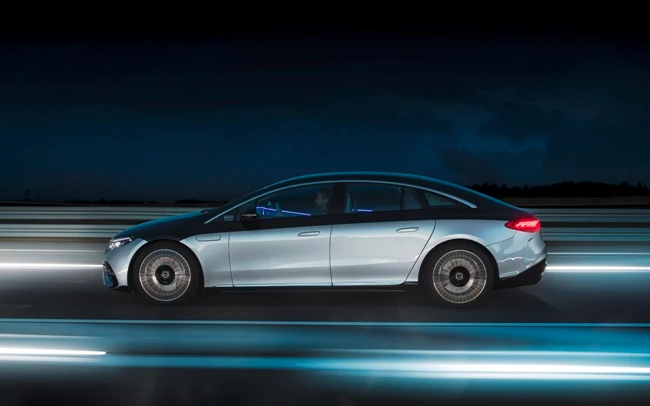
Mercedes-EQ, EQS, V 297, 2021
Also available as OTA or over the air will be the activation of vehicle functionalities. This includes two driving programs for younger aged drivers and for service staff. Light entertainment in the installation of games will also be available. Plus the updates will allow personal preference settings such as changing the steering angles for the rear wheel steering from the standard 4.5 degrees to the maximum 10 degrees. Planned is the activation of subscription services and testing on future programs.
Aerodynamics plays a big part in vehicle fuel efficiency and the new EQS has plenty of aero in the design. in fact, it’s currently rated as the most aerodynamic car available with a drag coefficient of 0.20cD. In conjunction with that slippery body is the reduction of wind noise at speed, improving comfort levels.
The need for aero is due to the EQS being on a new chassis architecture to provide a home for the powertrain. Mercedes-Benz calls the design language Sensual Purity, with smooth, organic, lines, a reduction in the join lines in panels, the fastback styling. The front end is a “Black Panel” look with the headlights running seamlessly into the grille panel which can be optioned with a 3D star pattern to complement the three-pointed Mercedes star.
Embedded throughout the EQS is a network of sensors, up to 350 of them, depending on specification. Amongst the types of information recorded are distance travelled, ambient lighting conditions, acceleration rates and speeds achieved. AI then utilises these datasets to adjust the car on the fly. This includes monitoring the battery charge levels in respect to the distance required to see the next charging point thanks to the onboard Navigation with Electric Intelligence.
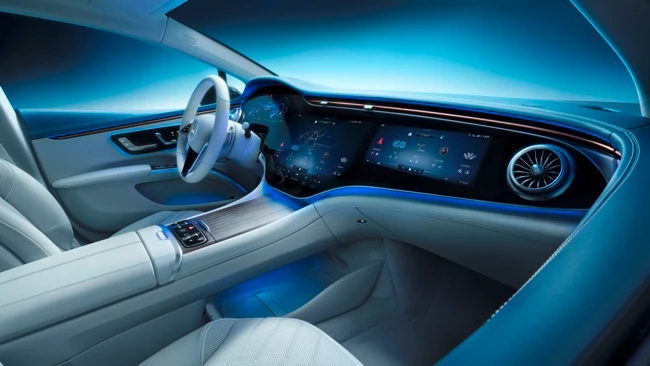
Mercedes-EQ, EQS 580 4MATIC, Interieur, Nevagrau/ Iridescentblau, AMG-Line, Edition 1; MBUX Hyperscreen; ( Stromverbrauch kombiniert: 20,0-16,9 kWh/100 km; CO2-Emissionen kombiniert: 0 g/km) // Mercedes-EQ, EQS 580 4MATIC, Interior, neva gray/ iridescent blue, AMG-Line, Edition 1; MBUX Hyperscreen ; (combined electrical consumption: 20.0-16.9 kWh/100 km; combined CO2 emissions: 0 g/km)
Being a class-setting EV, the EQS packs in some high-end green technology for the passengers. An example is the HEPA filter than can be set to fully clean the air inside the cabin before passengers enter with the onboard data system, MBUX, able to display particulate levels inside and out. Recycled materials are used in areas such as the carpets. The manufacturing process is fully carbon-offset as well.
The MBUX Hyperscreen is the absolute highlight in the interior. This large, curved screen unit sweeps almost from A-pillar to A-pillar. Three screens sit under a cover glass and appear to merge into one. The 12.3-inch OLED display for the front passenger gives him or her their own display and control area. The entertainment functions are only available there while the car is being driven in accordance with the country-specific legal regulations. Mercedes-EQ relies on an intelligent, camera-based locking logic: if the camera detects that the driver is looking at the front passenger display, it is automatically dimmed.
As part of its Ambition 2039 initiative, Mercedes-Benz is working on offering a carbon-neutral new car fleet within 20 years from now. By as early as 2030, the company wants more than half the cars it sells to feature electric drive systems – this includes fully electric vehicles and plug-in hybrids. In many areas, Mercedes is already thinking about tomorrow today: the new EQS is designed to be correspondingly sustainable. The vehicles are produced in a carbon-neutral manner, and resource-saving materials such as carpets made from recycled yarn are used. This is because Mercedes-Benz considers the entire value chain, from development and the supplier network to its own production. Mercedes-Benz AG has had its climate protection targets confirmed by the Science Based Targets Initiative (SBTI).
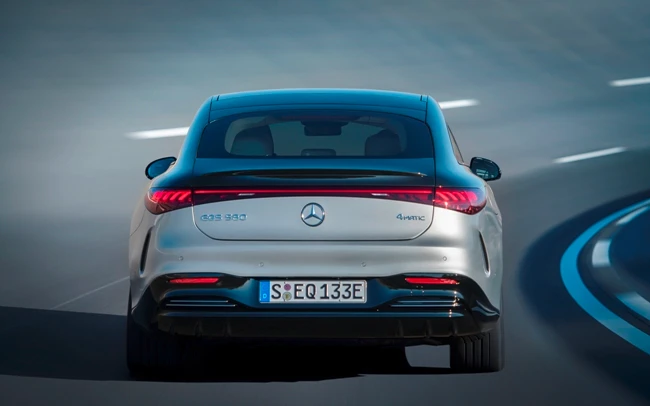
Mercedes-EQ, EQS, V 297, 2021
New Internal Combustion Engine Technology

Are the days numbered for the internal combustion engine? With ever stricter emission standards becoming the norm and all the talk about electric vehicles being the current rave, you would have to be forgiven for thinking that the future for the internal combustion engine is looking rather bleak. However, here are some findings that suggest that the internal combustion engine might just be around for quite some time yet.
Let’s start off with one of the world’s biggest automotive manufacturers: Toyota. Toyota continues to employ their hugely effective hybrid technology in many of their current models. Even the little Yaris has just recently had its own special hybrid motor become available to its line-up. Toyota’s hybrid systems are so successful at being efficient and they are proven in everyday, real-world situations to be reliable. You only have to look at the incredibly low fuel consumption figures of the latest Camry Sedans and RAV4 SUVs to get an insight into how effective Toyota hybrid engines are at lowering fuel consumption and reducing pollution levels in and around CBDs.
But there are also other areas of the internal combustion engine that haven’t been pushed quite to the boundaries of exploration and these are in the areas of compression ignition. ‘Engineering Explained’ host Jason Fenske has recently talked about homogeneous charge compression ignition (HCCI) being a big gain area for the internal combustion engine, particularly for the engine’s burning efficiency. The HCCI engine burns gasoline but uses compression ignition like a diesel engine rather than a spark plug. So, in theory, gasoline/petrol HCCI technology provides huge efficiency gains like you find with some of the current diesel motors; however, the huge efficiency gains would be without the soot and high levels of nitrogen-oxide (NOx) emissions. HCCI does require much finer controls in the area of fuel intake temperature, as well as the timing of ignition to get spot on.
Another vicinity that Fenske sees as being a big gain aera for internal combustion engine technology is the area of pre-mix charge compression ignition (PCCI). What PCCI does is inject some of the fuel early to let it mix with air in the combustion chamber, before injecting more fuel later on in the combustion process. This method of combustion provides more control over the engine’s ignition timing than HCCI, however it can also create pockets of unburned hydrocarbons. The key here is to limit the unburned hydrocarbons but access the higher efficiency potential that PCCI offers.
Then there is reactivity-controlled compression ignition (RCCI), where Fenske suggests that this technology uses two fuels, where one fuel is a low-reactivity fuel (like gasoline) that is port injected, and a high-reactivity fuel (like diesel) that is direct injected. “Reactivity” refers to a fuel’s tendency to ignite under compression. RCCI is a method that leads to big gains in fuel efficiency, where Fenske says that some lab research has shown 60% gains in fuel efficiency.
Something else that is being worked on by researchers from Valencia’s Polytechnic University (UPV) is that of a new internal combustion engine that does not generate carbon dioxide and other harmful gases. According to the engine’s designers, it is a “revolutionary” engine that meets the regulation on emissions planned for 2040 and also has excellent efficiency. There master stroke is in using special ceramic membranes in the engine’s design, these membranes enable the selective separation of oxygen from the air to produce ‘oxycombustion’, where pure combustion gas is generated. This pure combustion gas that is composed of water and CO2 can be captured inside the vehicle and stored, without having it expelled from the exhaust system.
Motoring big wigs, Toyota and Ferrari, still have an extensive long-term plan for using internal combustion technology into the future. Hybrid technology is delivering impressive gains in fuel efficiency and emission reduction, particularly in built up, congested areas.

X Marks The Spot For Genesis
Genesis has unveiled a new concept car. A stylish, low set coupe, the Genesis X is an EV and GT (Gran Turismo)for the future. Launched in a hi-tech media joint presentation with Jason B. Bergh with the location being a private rooftop in Los Angeles, and a showing of a film that brought together the Californian car culture to meet the vision of Genesis and its sustainable ideals, Genesis X highlights a different take on concept cars. A key visual identification of the concept is the Genesis Two Lines element. Seen in the company’s current vehicles, the Two Lines is extended on the concept, both on the exterior and interior, and the charging devices built in.
A key visual identification of the concept is the Genesis Two Lines element. Seen in the company’s current vehicles, the Two Lines is extended on the concept, both on the exterior and interior, and the charging devices built in.
Exterior design work sees the bonnet a one-piece “clamshell” unit, presenting a harmonious and uniform surface. The unbroken appearance allowed the designers to highlight the Two Lines idealism with both fenders having an unbroken sweep of lights strips from either side of the signature Genesis grille towards the door lines.
The grille’s structure has been reworked for a deeper three dimensional presence, and the interior sections have been painted the same Lençóis Blue as the concept’s exterior. The colour is said to evoke the hue seen in the lagoons of the Maranhenses National Park in Brazil, where a lake forms only during the rainy season. This sits above a classically styled air intake and thinner lines for the grille structure.
This brings to the Genesis X concept a sporting look yet functionality isn’t overlooked, with air to cool the electrics and batteries, channeling air through a aero-designed undertray for efficiency and increased drag reduction for better range. Jay Chang, the Global Head of the Genesis Brand, observed: “The car that we are unveiling today is a concept car that embodies the essential elements that Genesis pursues in its designs. Please take a moment to meet the future of Genesis design through this concept car, which embodies our brand’s progressive and audacious spirit.” SangYup Lee, the brand’s Global Design Chief, echoes that with: “The Genesis X Concept can be described as the ultimate vision of Athletic Elegance, the inherent design language of Genesis. The signature Two Lines theme and sustainable luxury will be blueprints for the futuristic designs and state-of-the-art technologies that Genesis seeks to adopt in its future models.”
Jay Chang, the Global Head of the Genesis Brand, observed: “The car that we are unveiling today is a concept car that embodies the essential elements that Genesis pursues in its designs. Please take a moment to meet the future of Genesis design through this concept car, which embodies our brand’s progressive and audacious spirit.” SangYup Lee, the brand’s Global Design Chief, echoes that with: “The Genesis X Concept can be described as the ultimate vision of Athletic Elegance, the inherent design language of Genesis. The signature Two Lines theme and sustainable luxury will be blueprints for the futuristic designs and state-of-the-art technologies that Genesis seeks to adopt in its future models.”
In profile it’s a classic GT motif, with long bonnet and truncated rear, joined by a gentle parabolic curve that in a quarter view highlights the tapering cabin and rear wheel flares. The rear has a dual parabola oval that houses the Two Lines taillights. There is no visible bootline seen in the concept though. The rear window has a pair of metallised strips that visually counterbalance the front and look to be, on the left side, the port for the charging of the battery. There’s more aero and tech with the wing mirrors eschewing the traditional glass mirrors. Here, Genesis goes slimline and embeds digital cameras. Aero and sportiness are combined in the bespoke, yet simple, five spoke wheels. These will cool the brake calipers whilst minimising drag at speed. For the interior Genesis highlight their “green” aspirations with “upcycled” leather trim. These are made from leftover materials, rather than sourcing them from new. In a weave pattern, the material is used on sections of the steering wheel, the safety belts, and the airbag cover. Also, to differentiate between driver and passenger for the four seater coupe, the trim designers took the unusual route of using two different colours. The passenger’s trim is Ocean Wave Green Blue, the driver’s a Scotch Brown.
For the interior Genesis highlight their “green” aspirations with “upcycled” leather trim. These are made from leftover materials, rather than sourcing them from new. In a weave pattern, the material is used on sections of the steering wheel, the safety belts, and the airbag cover. Also, to differentiate between driver and passenger for the four seater coupe, the trim designers took the unusual route of using two different colours. The passenger’s trim is Ocean Wave Green Blue, the driver’s a Scotch Brown. There’s further differentiation with the driver’s seat separated from the passenger via a solid looking floating console with a wrap around binnacle enveloping the driver’s section. This houses the Free-Form display, which manages various functions such as clusters, navigation and HVAC (heating, ventilation, and air conditioning) systems, and the Crystal Sphere Electronic Shift Lever, which integrates driving mode settings. Again, the designers have woven in the Two Lines ideal, with the binnacle drawing the lines to the air vents and side window mouldings.
There’s further differentiation with the driver’s seat separated from the passenger via a solid looking floating console with a wrap around binnacle enveloping the driver’s section. This houses the Free-Form display, which manages various functions such as clusters, navigation and HVAC (heating, ventilation, and air conditioning) systems, and the Crystal Sphere Electronic Shift Lever, which integrates driving mode settings. Again, the designers have woven in the Two Lines ideal, with the binnacle drawing the lines to the air vents and side window mouldings. To debut the Genesis X Concept to consumers around the globe, the brand opened its digital motor show website (digitalmotorshow.genesis.com) with the unveiling of the concept car, offering visitors various interactive experiences and 360-degree views of its interior and exterior.
To debut the Genesis X Concept to consumers around the globe, the brand opened its digital motor show website (digitalmotorshow.genesis.com) with the unveiling of the concept car, offering visitors various interactive experiences and 360-degree views of its interior and exterior.
At the time of writing, Genesis had not released details of the EV drive.
Hydrogen Fuel Is The Nexo Step.
Hyundai Australia has unveiled their Nexo vehicle. Powered solely by hydrogen, it’s set to be a game-changer if the right infrastructure is put in place. For now, a fleet of twenty will roam the streets of Canberra during a trial phase. Nexo is powered by a hydrogen fuel cell, rated at 95kW, coupled to an electric motor. It generates 120kW and 395Nm, and has a theoretical range of over 660 kilometres. Here’s how it works, says Hyundai.
Nexo is powered by a hydrogen fuel cell, rated at 95kW, coupled to an electric motor. It generates 120kW and 395Nm, and has a theoretical range of over 660 kilometres. Here’s how it works, says Hyundai.
Hydrogen gas is stored in high-pressure tanks and is sent from these to the fuel cells. It mixes with oxygen taken straight from the atmosphere and reacts across a “catalyst membrane” and creates electricity for the engine and battery, and water as the sole by-product. Excess power is stored in the battery system. Fuel Cell Electric Vehicles, or FCEVs, can be refilled in virtually the same time as a petrol fuel tank.
“The arrival of NEXO on Australian roads as an ADR-approved production vehicle is a landmark in Hyundai’s ongoing commitment to green mobility and to hydrogen fuel cell electric vehicle technology.” Hyundai Motor Company CEO, Jun Heo said. The hydrogen NEXO SUV is a cornerstone in the Hyundai portfolio, complementing our hybrid, plug-in hybrid and battery electric vehicles the IONIQ and Kona Electric. NEXO is also a sign of things to come, as Hyundai continues in its long-term drive towards leadership in eco-friendly vehicles.”

It’s a one specification vehicle for the moment, and comes well equipped in that sense. A main 12.3 inch satnav equipped touchscreen is the centre of the appeal, complete with Android and Apple smartphone compatibility. The driver has a 7.0 inch info screen, and a Qi wireless smartphone charger is standard.
Seats are leather appointed, and passengers see the sky via a full length glass roof. Sounds are courtesy of Krell. Nexo rolls on 19 inch alloys, and sees its way thanks to LED headlights and daytime running lights.  A Surround View Monitor, Remote Engine Start, Remote Smart parking Assist, and a powered tailgate add extra convenience. Comfort comes courtesy of a dual-zone climate control system, powered front seats, heating for the steering wheel and outboard sections of the rear seats.
A Surround View Monitor, Remote Engine Start, Remote Smart parking Assist, and a powered tailgate add extra convenience. Comfort comes courtesy of a dual-zone climate control system, powered front seats, heating for the steering wheel and outboard sections of the rear seats.
SmartSense is the name Hyundai give their safety system package and the Nexo will have Forward Collision Avoidance, Driver Attention warning, and the Blind Spot Collision Avoidance is radar based. Lane Keep Assist, Rear Cross Traffic Avoidance Assist and Smart Cruise with Stop/Go functionality are also standard.
Exterior colour choices are limited. White Cream Mica, and a Dusk Blue Metallic will come with Stone Grey two-tone interior, whilst Cocoon Silver and Copper Metallic are paired with a Dark Blue interior.
The main hydrogen system is built around three storage tanks with a capacity of 156 litres. Up to 6.33 kilograms of hydrogen can be held at a pressure of 700 bar. The testing of the tanks has included structural integrity for collision impacts. The battery is a lithium-ion polymer unit, rated as 240V and 1.56kWh. It also assists in running the onboard 12V systems.
The battery itself effectively comprises most of the floor, making for better cabin packaging and a low centre of gravity. The system is also rated for cold start operation at temperatures down to -29 Celcius. It will start within 30 seconds.
In keeping with its green credentials, structural components include aluminium for the bumper beam, front knuckles, rear wheel carriers and front lower control arms. Lower kerb weight assists in the vehicle’s handling, ride, and reduces cabin noise input. The front fenders are lightweight and flexible plastic.
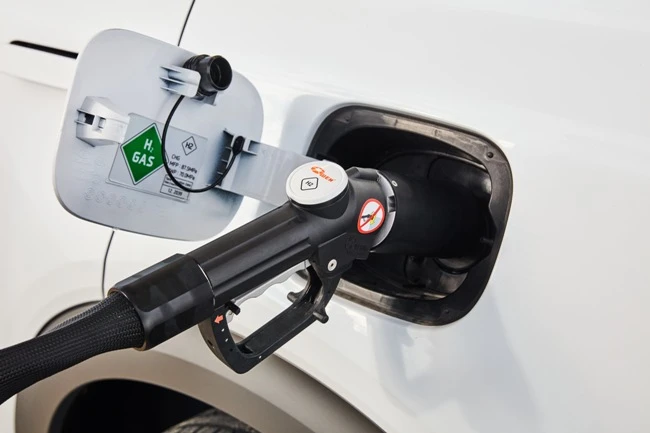
Hyundai Nexo refill
Bio-based materials also up the green, with up to 12.0 kilograms of CO2 being reduced as a by-product of the manufacturing process. Total weight of bio-product is 34 kilos and this is found in the carpet, headliner, trim material, door trims, and the seats and console. Bio-paints derived from corn and sugarcane waste material are also used.
Strength and safety comes from high tensile steel, making the monocoque body both rigid and torsionally strong, with over 56% of the Nexo’s bodywork made from the high strength steel/ This extends to the tank sub-frame and tested in rear collision simulations.
Hidden details such as air guides underneath and air deflectors aid aero efficiency. Hidden wipers, a Hyundai first, are fitted at front and rear, and with slimline retracting door handles the Nexo has a drag coefficient of just 0.32cD. Chassis development was carried out in Australia, Tim Rodgers, the Hyundai Motor Company Australia Product Planning and Development Specialist, said. “The platform was designed to address this challenge, with an extensive use of lightweight parts for the strut front and multi-link rear suspensions, such as aluminium knuckles and lower control arms. By reducing unsprung mass there is less energy that we have to manage through the damper and the spring, so we can use a slightly different valve characteristic and achieve the results we require.
Chassis development was carried out in Australia, Tim Rodgers, the Hyundai Motor Company Australia Product Planning and Development Specialist, said. “The platform was designed to address this challenge, with an extensive use of lightweight parts for the strut front and multi-link rear suspensions, such as aluminium knuckles and lower control arms. By reducing unsprung mass there is less energy that we have to manage through the damper and the spring, so we can use a slightly different valve characteristic and achieve the results we require.
We’ve come out of the R&D process with a refined suspension that matches quite nicely with acoustic levels in the cabin. Beyond achieving this, the tuning program targeted the normal ride and handling benchmarks, to give NEXO the same style of body control we tune into all our cars, and the same level of competency Australia’s notoriously challenging back roads.”
Not yet available for private sale, it can be leased. Hyundai have a specialist Aftersales team in place to deal with inquiries, and they can be reached through a Hyundai dealership in the first instance.
